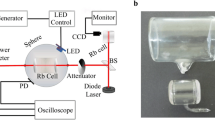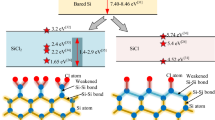Abstract:
The light induced atomic desorption effect, known as LIAD, is observed whenever Pyrex cells, coated with siloxane films and containing alkali atoms, are illuminated. LIAD is a non-thermal phenomenon and it can be observed even with very weak light intensities. We show that the simultaneous contribution to the photo-emission of atoms adsorbed both at the film surface and within the film must be taken into account in order to fit the experimental data. We demonstrate that both the desorption efficiency and the diffusion coefficient of the alkali atoms embedded in the dielectric film depend on the desorbing light intensity. These features characterize a new class of photo-induced phenomena whose analysis gives new insights in the comprehension of the atom-surface interaction and of the atom-bulk diffusion and opens interesting perspectives for applications.
Similar content being viewed by others
Author information
Authors and Affiliations
Additional information
Received 27 April 2000 and Received in final form 15 September 2000
Rights and permissions
About this article
Cite this article
Marinelli, C., Nasyrov, K., Bocci, S. et al. A new class of photo-induced phenomena in siloxane films. Eur. Phys. J. D 13, 231–235 (2001). https://doi.org/10.1007/s100530170271
Issue Date:
DOI: https://doi.org/10.1007/s100530170271




